

Cancer Caught on Video.
Johns Hopkins Comprehensive Brain Tumor Center. At Johns Hopkins, the brain tumor team will perform a variety of examinations to diagnosis a brain tumor.
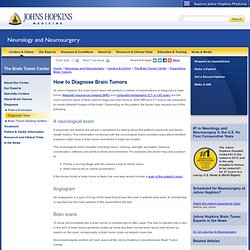
Magnetic resonance imaging (MRI) and computed tomography (CT or CAT scan) are the most common types of tests used to diagnose brain tumors. Both MRI and CT scans use computers to create detailed images of the brain. Depending on the patient, the doctor may request any of the following: A neurological exam A physician will assess the person’s symptoms by asking about the patient’s personal and family health history. The neurological exam includes checking vision, hearing, strength, sensation, balance, coordination, reflexes and ability to think and remember. Follow a moving finger with the person’s eye to check visionWalk heel-to-toe to check coordination If the doctor thinks a brain tumor is likely, the next step would include a scan of the patient’s brain.
Cancer Biology – Inside Cancer: A Multimedia Guide to Cancer. How Normal Cells Become Brain Cancers. Brain tumor specimens taken from neurosurgery cases at the University of California, San Francisco (UCSF) Medical Center has given scientists a new window on the transformation that occurs as healthy brain cells begin to form tumors.
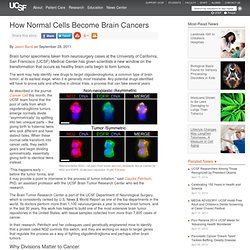
The work may help identify new drugs to target oligodendroglioma, a common type of brain tumor, at its earliest stage, when it is generally most treatable. Any potential drugs identified will have to prove safe and effective in clinical trials, a process that can take several years. Representative NG2+ cell pairs from tumor and non-neoplastic tissue stained for NG2 and EGFR. Scale bars represent 10 μM. Full size As described in the journal Cancer Cell this month, the UCSF team found that the pool of cells from which oligodendroglioma tumors emerge normally divide “asymmetrically” by splitting into two unequal parts – like giving birth to fraternal twins who look different and have distinct fates.
Claudia Petritsch, PhD Figure: C.Petritsch/UCSF. Cancer and Quantum Mechanics. A physicist working on cancer?
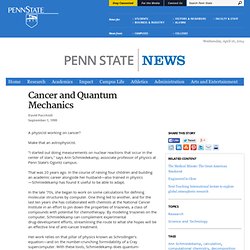
Make that an astrophysicist. "I started out doing measurements on nuclear reactions that occur in the center of stars," says Ann Schmiedekamp, associate professor of physics at Penn State's Ogontz campus. That was 20 years ago. In the course of raising four children and building an academic career alongside her husband—also trained in physics—Schmiedekamp has found it useful to be able to adapt.
In the late '70s, she began to work on some calculations for defining molecular structures by computer.
Fisica y Cancer (Spanish) Tumor Imaging. Biological Physics. Cancer. Tutorial #7: Physics of Cancer. Applying particle physics expertise to cancer therapy. (PhysOrg.com) -- Physicists at the University of California, Santa Cruz, are working with medical researchers at Loma Linda University Medical Center to develop a new imaging technology to guide proton therapy for cancer treatment.

Proton therapy is a type of radiation therapy that allows powerful doses of radiation to be delivered directly to a tumor with little damage to the surrounding healthy tissues. Currently, images and data for planning and guidance of proton therapy are obtained from x-ray computed tomography (commonly known as a CT scan or CAT scan). But using information from x-rays to guide proton beams results in uncertainties that limit the accuracy with which the tumor can be targeted.
To overcome these limitations, researchers at the Santa Cruz Institute for Particle Physics (SCIPP) at UC Santa Cruz and their collaborators have been working since 2003 to develop the technology needed to perform proton computed tomography. Brain Tumor 2011 - Scientific Program. National Brain Tumor Society. A systems biology approach to invasive behavior: comparing cancer metastasis and suburban sprawl development. Structural Similarities The most simplistic observation is readily detected by comparisons of histological examination of cancer versus satellite imaging of city growth (Figure 1).

Suburban sprawl and malignant cancers both display an invasive style of growth, employing local and long-distance mechanisms. In fact the growth of both systems has been shown to fit the mathematical description of a fractal pattern [6-14], though the two structures have not been directly compared. An important aspect of this comparison is that sprawl growth, while having emergent properties, is largely dictated by documented man-made laws. There have also been many attempts, some successful, in limiting or preventing sprawl growth. Figure 1. 4Vol4. Robijn Bruinsma, UCLA, Physics and Mathematics of Cancer Metastasis. Physicsatmit_10_cancerctr. Dissecting cancer through mathematics: from the cell to the animal model : Abstract : Nature Reviews Cancer. Tissue Geometry Plays Crucial Role in Breast Cell Invasion. Apropos of National Breast Cancer Awareness month, researchers with the U.S.
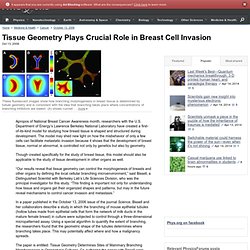
Department of Energy’s Lawrence Berkeley National Laboratory have created a first-of-its-kind model for studying how breast tissue is shaped and structured during development. The model may shed new light on how the misbehavior of only a few cells can facilitate metastatic invasion because it shows that the development of breast tissue, normal or abnormal, is controlled not only by genetics but also by geometry. Though created specifically for the study of breast tissue, this model should also be applicable to the study of tissue development in other organs as well. “Our results reveal that tissue geometry can control the morphogenesis of breasts and other organs by defining the local cellular branching microenvironment,” said Bissell, a Distinguished Scientist with Berkeley Lab’s Life Sciences Division, who was the principal investigator for this study.
Source: Lawrence Berkeley National Laboratory. Why victory in the war on cancer remains elusive: biomedical hypotheses and mathematical models. Center for Computational Science. Innovative Technologies : Vanderbilt-Ingram Cancer Center. Innovative Technologies Vanderbilt University Medical Center is one of the nation’s premier medical institutions. Modeling Cancer Biology. New Imaging Analysis Predicts Brain Tumor Survival. As early as one week after beginning treatment for brain tumors, a new imaging analysis method was able to predict which patients would live longer, researchers from the University of Michigan Comprehensive Cancer Center have found.

The method uses a standard magnetic resonance imaging, or MRI, protocol to monitor changes over time in tumor blood volume within individual voxels of the image, rather than a composite view of average change within the tumor. This parametric response map allowed researchers to see specific areas in which tumor blood volume increased or decreased, that may have canceled each other out when looking at the changes as an average. Researchers Pinpoint Origin Of Deadly Brain Tumor - Oligodendrogliomas. The Mathematics Of Cancer - Forbes.com. Mathematical modeling and cancer.
Sara Wheelan on the Mathematics of Cancer.MP4. ASU Cancer Research. Interview with Dr. Timothy Newman - Director, ASU Center for Biological Physics. ICMS. Mar 26, 2007 - Mar 30, 2007 West Park Conference Centre, Dundee Organisers Short Report.

Math helps track down cancer behavor. Could Physics Cure Cancer? Making physics the new weapon in war on cancer. IEO Interviews: Mathematics, theoretical physics, computational sciences and cancer. Unraveling the physics of cancer. October 26, 2009Print version The Johns Hopkins Engineering in Oncology Center at INBT will be headed by Denis Wirtz, left.

Gregg Semenza will serve as associate director. Researchers from the Johns Hopkins Institute for NanoBioTechnology have been awarded a $14.8 million grant from the National Cancer Institute to launch a research center aimed at unraveling the physical underpinnings that drive the growth and spread of cancer. The new Johns Hopkins Engineering in Oncology Center at INBT includes 11 Johns Hopkins faculty members affiliated with the INBT and four investigators from partner universities. The Jackson Cancer Modeling Group. Research Overview As a group of genetic diseases, cancer presents some of the most challenging problems for basic scientists, clinical investigators, and practitioners.
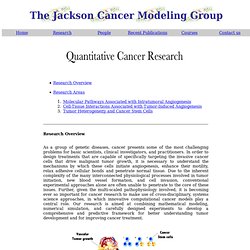
In order to design treatments that are capable of specifically targeting the invasive cancer cells that drive malignant tumor growth, it is necessary to understand the mechanisms by which these cells initiate angiogenesis, enhance their motility, relax adhesive cellular bonds and penetrate normal tissue. Due to the inherent complexity of the many interconnected physiological processes involved in tumor initiation, new blood vessel formation, and cell invasion, conventional experimental approaches alone are often unable to penetrate to the core of these issues. Further, given the multi-scaled pathophysiology involved, it is becoming ever so important for cancer research to make use of cross-disciplinary, systems science approaches, in which innovative computational cancer models play a central role.
Research Areas. Physics and Mathematics of Cancer. This program will be focused on physical and mathematical models of tumor initiation, progression, and metastasis, as well as the development of new physical probes of cancers. Theoretical physicists and mathematicians will join with prominent molecular biologists and oncologists, who will give overview talks. Particular topics that will be emphasized include genetic changes, signal transduction, tumor microenvironment and metabolic changes of cancer. Finally, the National Cancer Institute has recently established twelve physical oncology centers. One of the aims of the workshop is that it should serve as a platform for the discussion of ongoing projects in these centers, as well as an opportunity to discuss new results and concepts. The workshop will begin with a series of review lectures by Arnold Levine. Cancer research gets physical.
Cancer research has traditionally been the realm of biologists, and, more recently, engineers. Now, physicists are getting in on the action. MIT has been awarded a five-year grant from the National Cancer Institute (NCI) to start a new Physical Science-Oncology Center. The funding, approximately $3.5 million per year, will support four cancer research projects led by MIT physical scientists. Research Projects. Physicists team up to focus on cancer. Thursday 14 July 2011 Scientists from leading London research centres met this week to discuss new ways to help cancer patients by combining their strengths in physics, clinical activities and basic research. Clinical and research physicists from The Institute of Cancer Research (ICR) and The Royal Marsden NHS Foundation Trust met with counterparts from Imperial College London to find ways to turn the latest advances in physical science into applications that will improve diagnosis and treatment of cancer.
Professor Steve Webb, Chairman of the ICR and The Royal Marsden’s Joint Department of Physics, says: “Traditionally there has been somewhat ad-hoc interaction between medical physicists and non-biomedical physicists. This initiative brings together some of the leading researchers in their fields, and it’s clear from our discussions that it could lead to some really exciting and innovative collaborations in the future. " Statistical Physics and Theoretical Biophysics Group: Research Interests. Ruprecht-Karls-Universität Heidelberg. Physics and the fight against cancer - The Dayside. Fundamental physics enters war on cancer. The US is setting up a dozen new research centres to explore novel ways in which physics can be applied to the treatment of cancer.
The centres are being funded by the National Institutes of Health (NIH) as part of a five-year project, worth a total of $22.7m in its first year. Each centre will bring a non-traditional approach to oncology by considering the physical properties and dynamics of cancerous cells. "We will aim to inject some radical new thinking into the subject – opening a completely new front on the 'war on cancer'," says Paul Davies, director of the BEYOND Center for Fundamental Concepts in Science. Based at Arizona State University (ASU), BEYOND is one of the 12 centres that will receive NIH funding – it will get $1.7m for each of the first two years.
David Agus: A new strategy in the war on cancer. Publications - TCGA. People.healthsciences.ucla.